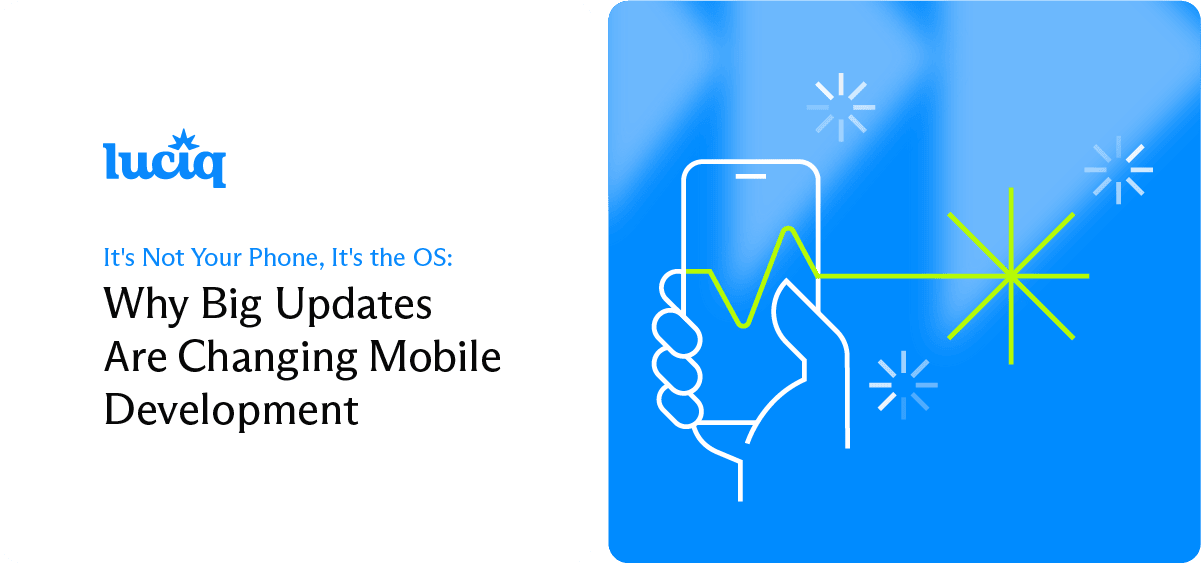For many users, the iOS 26 update came with a few unexpected quirks: a little sluggishness here, a spike in temperature there, or an app that used to open instantly now taking an extra beat. But beyond these surface-level glitches, large OS updates like iOS 26 are more than feature releases, they test mobile app performance, developer productivity, and enterprise reliability. These shifts underscore the growing complexity of iOS application performance monitoring, especially as mobile teams navigate evolving OS behaviors.
Luciq’s observability findings reveal a noticeable increase in cold app launches (Graph 1) and forced restarts (Graph 2) on iOS 26 compared to older OS versions: a trend that’s both measurable and consistently observable across user sessions.


Luciq’s observability findings confirm the broader performance volatility seen after major OS updates: a challenge that traditional iOS application performance monitoring tools often struggle to capture. These findings are echoed across Reddit, X, and GitHub, as well as independent coverage from Wccftech and Livemint, which report increased CPU and battery consumption, slower app launches, and unpredictable behavior across devices. Notably, this instability appears to disproportionately affect devices running iOS 26 - particularly the new iPhone 17 models - while older ones, like the iPhone Xs, remain largely unaffected.
User-Reported Mobile App Performance Issues After OS Updates
In iOS 26, Apple introduced powerful new developer tools, including Xcode 26 with AI-powered code assistance, faster build times, and improved documentation, but deep OS-level changes still challenge teams. Apple shipped iOS 26 with a long list of improvements and new Apple Intelligence features, but so are the reports of apps running hotter, slower, or draining batteries faster even weeks later.
Across forums, user threads, and tech publications, three consistent themes have emerged:
- Battery and thermal complaints: Many users report faster battery drain and overheating after updating to iOS 26. While Apple has acknowledged short-term slowdowns, public reporting shows lingering impact for some users.
- Perceptible slowness: App launches and animations are slower, even for high-performing apps. This is the kind of degradation that hurts mobile app performance before metrics even catch up.
- Changed performance profiles: With iOS 26 introducing Adaptive Power Mode and new AI-driven background processes, app performance is now more dynamic, and less predictable.
When OS updates shift app behavior in real time, teams need tools that anticipate issues, surface actionable insights, and help maintain developer velocity and mobile app performance, so they can focus on innovation, not firefighting. For mobile teams, this highlights a painful truth: performance issues are no longer just about your code. They’re about how your app behaves across evolving OS and hardware environments, and whether you have the mobile observability platform to understand and respond in real time. This is especially true for teams focused on iOS application performance monitoring, where visibility into client-side behavior is critical.
What OS Updates Mean for Mobile Observability and Developer Productivity
When performance issues emerge after an OS update, they don’t just frustrate users; they impact the business. Customer satisfaction scores dip. Support tickets spike. Ratings fall. And internally, mobile teams lose velocity as they scramble to diagnose regressions and align on fixes. Every delay ripples outward, affecting product roadmaps, release confidence, and executive trust.
For enterprises that depend on mobile as their primary customer channel, this underscores the urgent need for real-time visibility and proactive issue management. Mobile teams must be able to detect, understand, and communicate performance changes clearly, both to engineers and to non-technical stakeholders.
Big operating system updates are inevitable. When they roll out, they don’t just test how well apps perform, they test how fast teams can adapt and how clearly they can communicate the impact across the organization. And when an OS update changes app behavior dramatically, it’s not just a user experience problem, it’s a developer productivity and enterprise reliability problem; this is where mobile observability, powered by Agentic AI, becomes essential.
Why Traditional Tools Fail at Mobile Observability and iOS Performance Monitoring
Traditional observability tools were built for servers, not smartphones. They’re great at tracking backend uptime and API latency, but when an iOS update introduces new system behaviors, these tools hit a wall.
Mobile apps live on devices with varying battery health, chipsets, and system-level optimizations, and traditional tools fail to capture this rich, client-side context – missing crucial data like UI hangs, rage clicks, and visual context of a user’s session. When iOS changes thermal throttling or background task scheduling, the ripple effects hit every developer and every user differently.
And yet, most teams are left manually triaging issues after users experience them, pulling logs, replaying sessions, guessing root causes. It’s reactive, exhausting, and a massive drag on developer velocity. This is exactly why the industry needs a turning point, and why Agentic AI-powered mobile observability has become essential.
Luciq’s Agentic AI Approach to Mobile Observability
Luciq was built from the ground up to meet this moment. It’s not just another monitoring tool, it’s a paradigm-creating (and shifting) mobile observability platform that redefines how teams detect, analyze, resolve, and prevent issues through Agentic Mobile Observability.
That means Luciq doesn’t just tell you what’s broken. It helps fix it. At its core, Luciq gives developers the unrivaled clarity to see issues forming and the data-backed confidence to act, before users are impacted. By connecting every critical mobile signal, from APM and crash reports to Session Replay and Release Management, Luciq enables mobile teams to prevent regressions.
Here’s what that looks like in practice:
- Cross-OS visibility. Luciq’s observability surfaces changes tied to iOS versions, app releases, and device models, helping teams isolate OS-induced regressions in minutes.
- Intelligence for triage. Our platform uses data to automatically prioritize issues by business impact and surfaces the contextual details needed for Root Cause Analysis. This rich data foundation is the essential fuel for our evolving Agentic AI.
- Faster time to resolution. Developers get clean, contextualized insights - not noise - so they can spend less time debugging and more time building.
- Continuous improvement at enterprise scale. As an enterprise-ready AI-powered mobile development solution, Luciq scales with global teams, empowering them to deliver frustration-free mobile experiences across millions of users, protecting brand reputation and their bottom line.
Imagine a global retail app rolling out a major update just as iOS 26 launches. Suddenly, users on iPhone 17 devices start reporting crashes and slower load times. Without Luciq, the team might spend days manually reproducing the issue and parsing logs. With Luciq, agentic AI instantly detects that the spike in background terminations is isolated to iOS 26 devices, flag the regression, and surface the related code paths, helping developers ship a hotfix within hours. Meanwhile, product and customer teams can proactively communicate with affected users, preventing escalation and protecting brand trust.
This is the essence of Agentic Mobile Observability: observability that doesn’t just observe, but acts. Luciq is driving towards a future where your teams don't waste cycles fixing what's already broken. Instead, they can fix nothing, and build something that matters.
The Takeaway: Mobile Teams Need Agentic Observability to Stay Ahead of OS Changes
iOS 26 is a reminder that the mobile environment is always evolving. But with the right foundation, your response can be proactive, not reactive.
Agentic Mobile Observability represents that foundation. It’s the bridge between signal and action, between noise and insight, between firefighting and innovation. Luciq exists to make that shift possible. It’s not just about monitoring, it’s about enabling agentic AI-driven mobile observability that empowers teams to adapt faster and protect developer productivity at scale.







